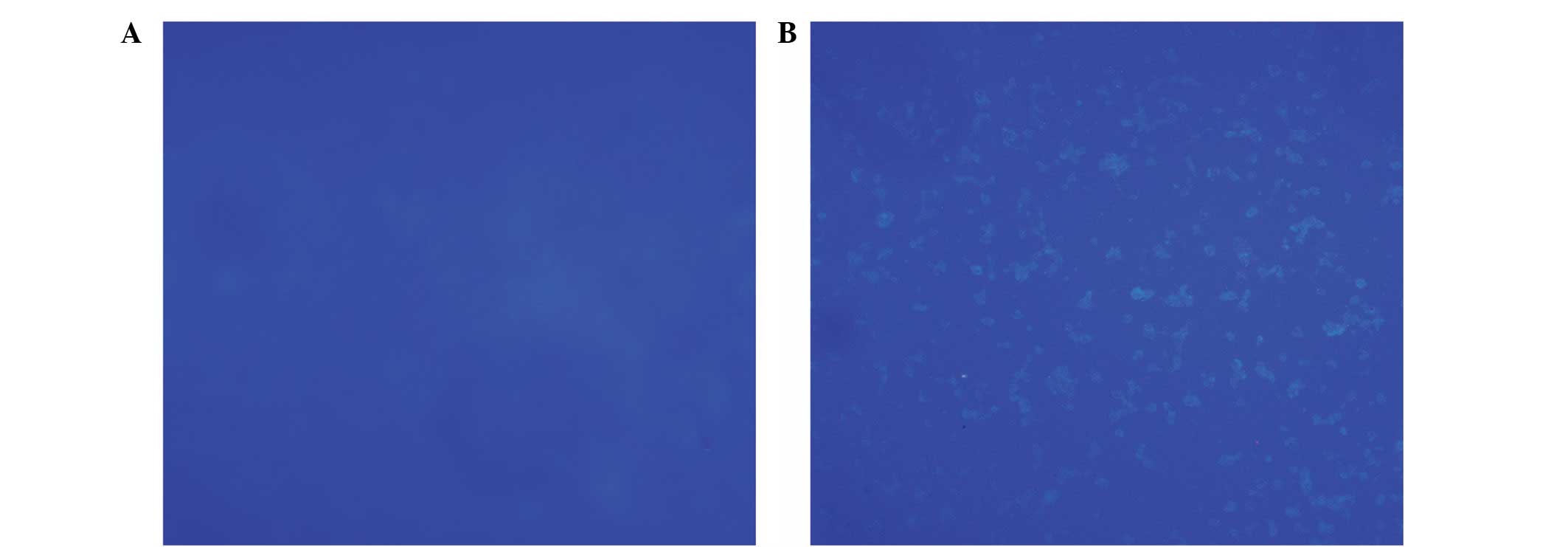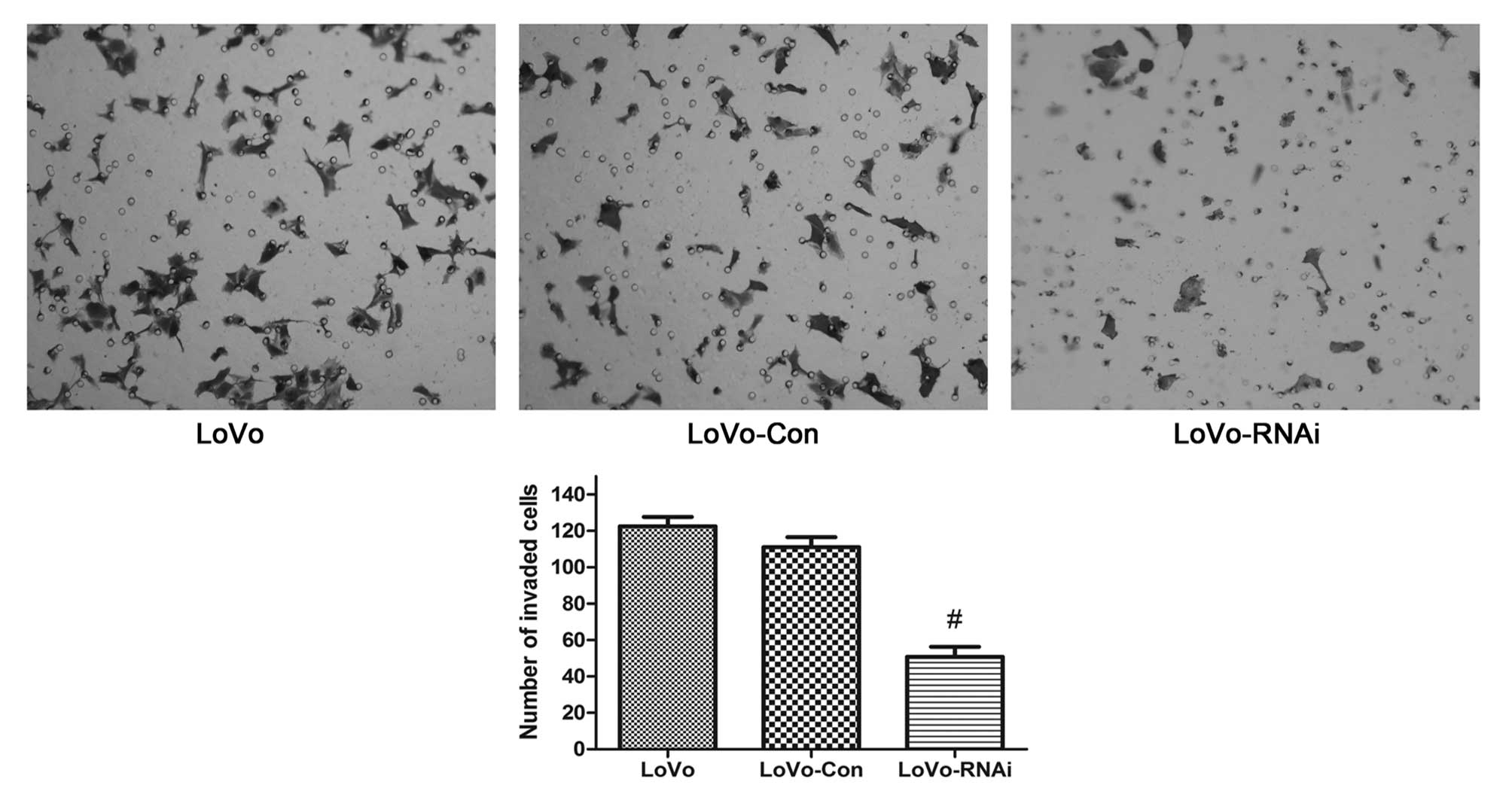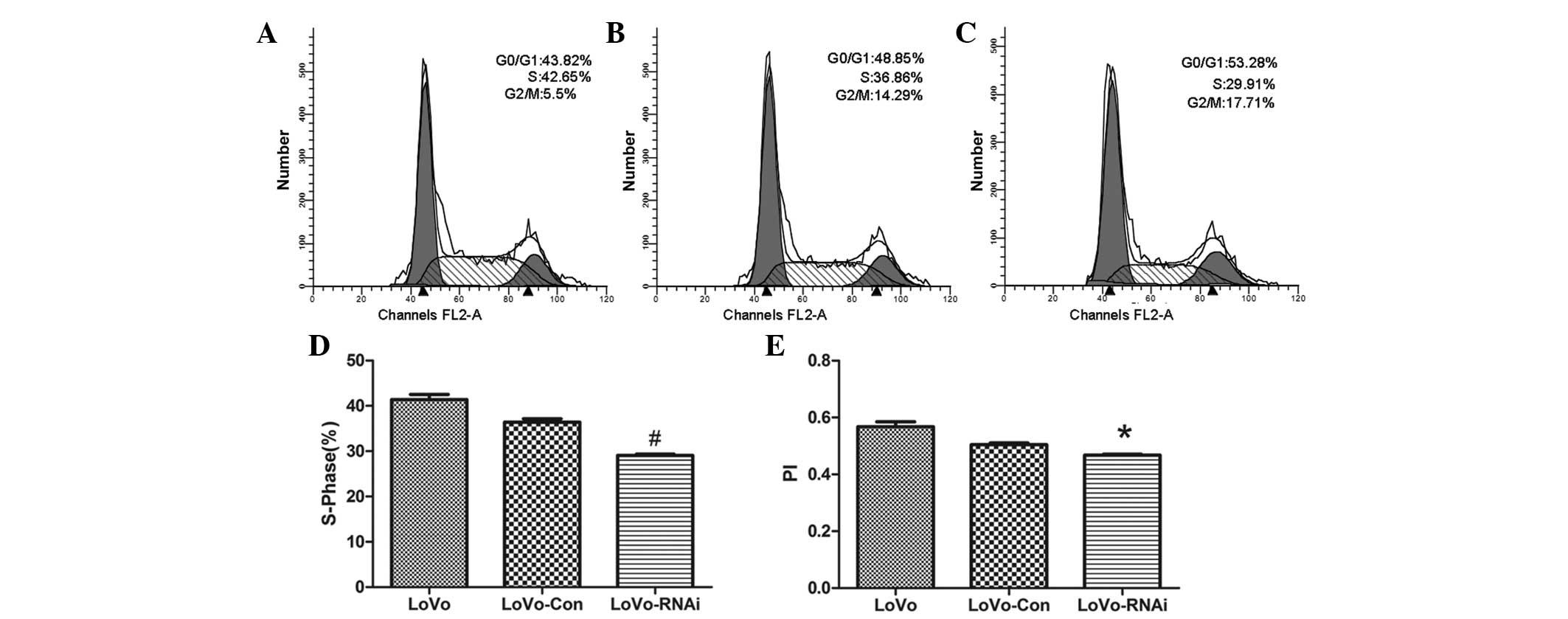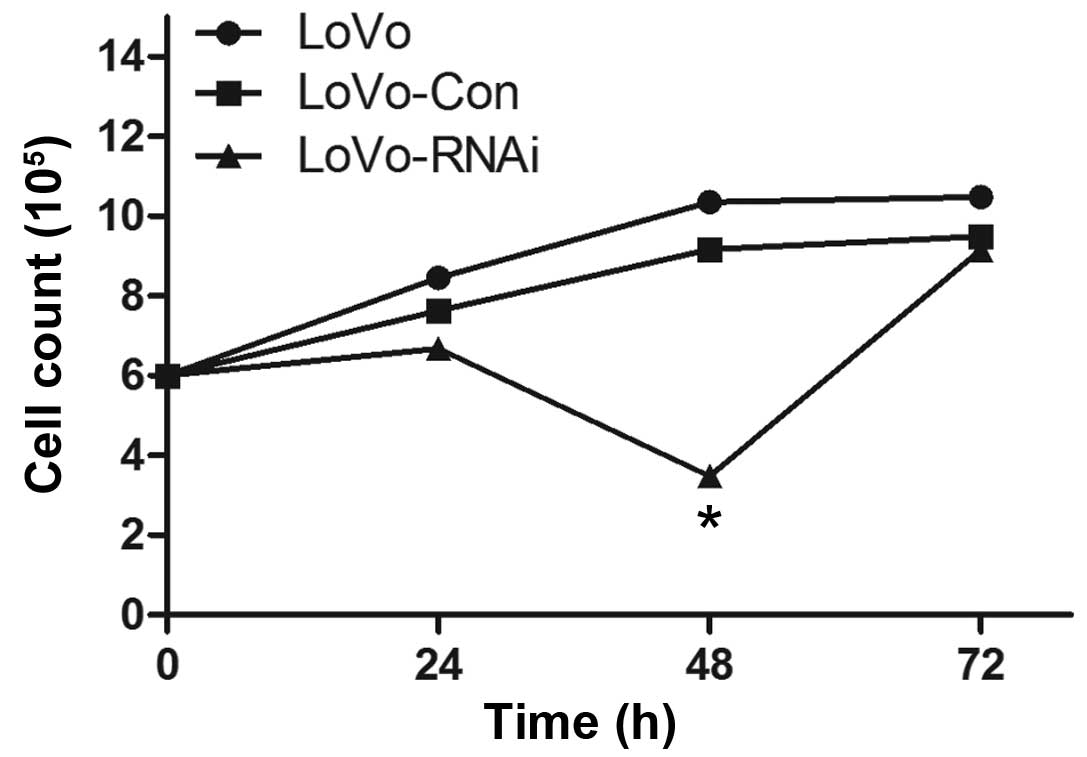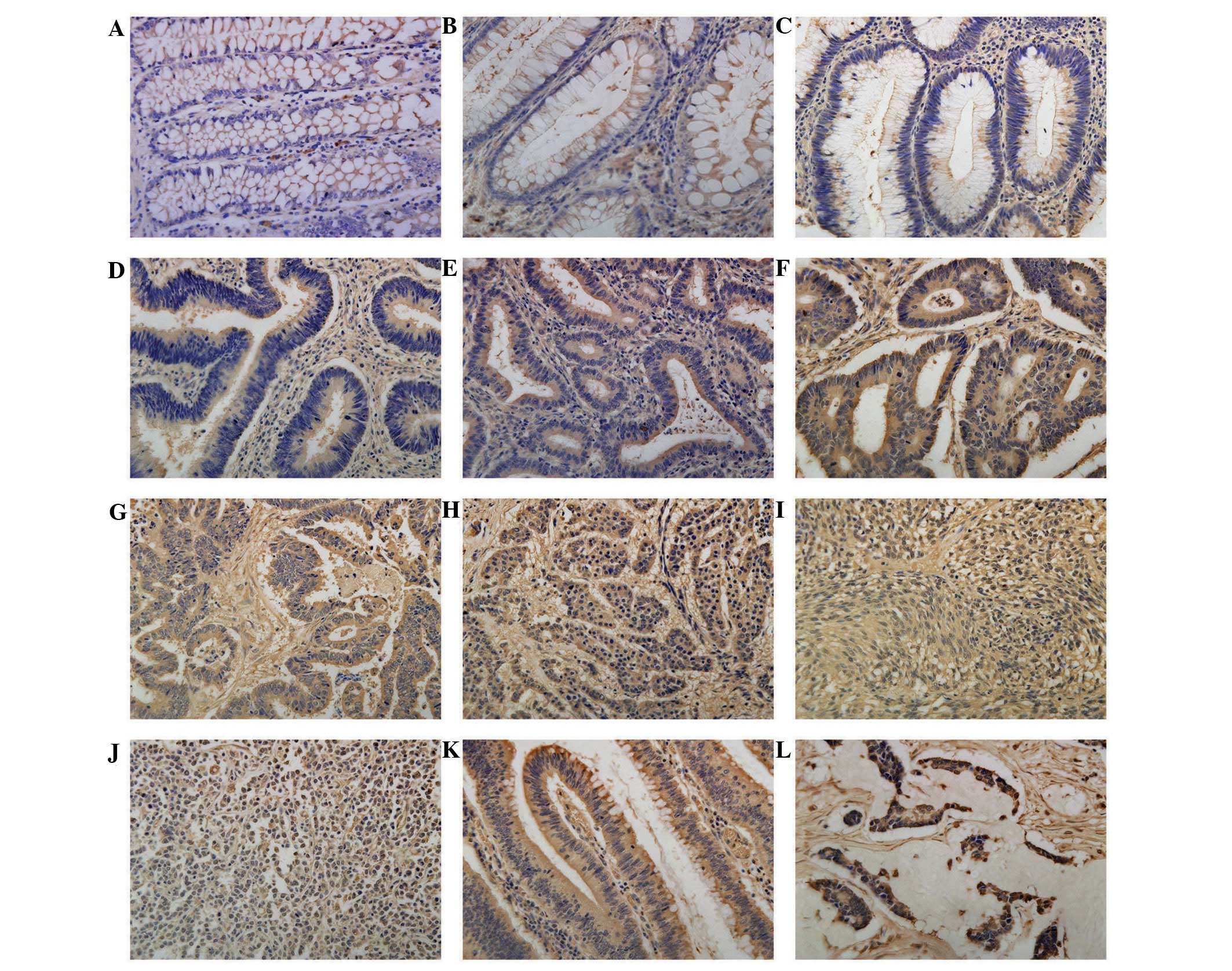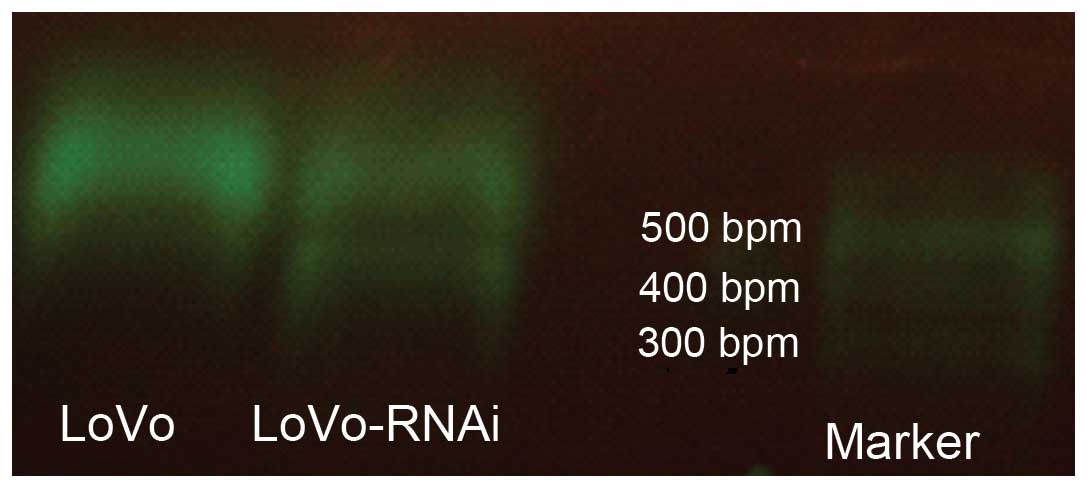Introduction
Colorectal cancer (CRC) is a highly prevalent cancer
in males and females, which is associated with a severe demographic
and economic burden worldwide. In the United Kingdom, one in every
20 people will be affected by CRC, which is often well established
and metastatic beyond the bowel at first diagnosis (1). Despite efforts to improve early
detection, the precise mechanisms underlying the malignant
consequences of colorectal cancer remain unclear. Inflammatory
syndromes, hereditary factors and environmental factors are all
risk factors associated with CRC (2). For the last two decades, the liver has
been the most frequent site of metastasis of colorectal cancer
(3), which affects the efficacy of
treatment and the prognosis of patients.
The receptor-interacting protein (RIP, RIPK) is
widely expressed in the majority of cell types. RIP is a family of
kinases that mediates cellular survival as well as inflammatory and
immune responses (4). There are
seven RIP proteins (RIP1–RIP7). The RIPs are 74-kDa proteins that
contain an N-terminal region and a C-terminal region that includes
an intracellular death domain (5).
RIP1 is the most important member of the RIPs, and it mediates
mitochondrial dysfunction, ROS and activation of the transcription
factor NF-κB, and is crucial for programmed necrosis. RIP1 is
required for the activities of TLR3 and TNF-α, as well as DNA
damage (6–8). RIP1 ultimately targets cellular
energetic metabolism and autophagy through mechanisms related to
innate and adaptive immunity (9).
If ubiquitination of RIP1 is blocked, necrosis ensues when caspases
are inhibited. Recruitment of NEMO to ubiquitinated RIP1 is
important for the TNFR1 signaling pathway, which determines whether
RIP1 triggers a necrotic death response (10). RIP1-deficient mice appear normal at
birth, but apoptosis occurs in the lymphoid and adipose tissues,
and the mice die at 1–3 days old (11). RIP1 inhibits caspase-8 cleavage and
TRAIL-induced apoptosis (12).
The association between RIP1 and colorectal cancer
has been previously studied. These studies revealed that RIP1
affects cellular proliferation, apoptosis, angiogenesis and cell
adhesion in tumor cells (13).
In the present study, RNA interference (RNAi) was
utilized with a HiGene to target RIP1 in colon cancer cells. RNAi,
which is mediated by double-stranded RNA, is a sequence-specific
and post-transcriptional gene silencing process. RNAi has become a
highly useful tool for functional genomics and represents a novel
therapeutic approach for treating human diseases that involve viral
infections (14). Currently,
RNA-based therapeutics that have the ability to silence the
expression of specific targets are used for the clinical
investigation of numerous disorders, including cancer. As the
mechanisms of tumor evasion from the host immune system are
versatile, to enhance the immune response against tumors, RNAi
technology is used to target numerous different molecules (15). In the present study, RIP1 small
interfering RNA (siRNA) was employed to knockdown the expression of
RIP1 and its effects on cell proliferation, migration, apoptosis,
the cell cycle, invasion and the related mechanisms were
investigated.
Materials and methods
Materials
The LoVo human colon cancer cell line was obtained
from the Cell Collection of Chinese Academy of Sciences (Shanghai,
China). The transfections were performed using HiGene (Applygen,
Beijing, China). The Annexin V-FITC/PI Apoptosis kit was obtained
from BioVision (Mountain View, CA, USA). The BD Matrigel™ Basement
Membrane matrix was purchased from BD Biosciences (San Jose, CA,
USA). Transwell plates were obtained from Corning, Inc.(Corning,
NY, USA) and 3-(4,5-dimethylthiazol-2-yl)-2,
5-diphenyltetrazoliumbromide (MTT) was purchased from Wuhan Kerui
Biological Technology Co., Ltd. (Hubei, China). TRIzol reagent was
obtained from Invitrogen Life Technologies (Carlsbad, CA, USA). The
Fermentas kit was purchased from MBI Fermentas (Amherst, NY, USA).
The 2× Taq PCR MasterMix was obtained from Tiangen Biotech Co.,
Ltd. (Beijing, China). Primers for human RIP1 and β-actin were
designed by Sangon Biotech Co., Ltd. (Shanghai, China), and the
sequences were as follows: Forward, 5′-GTC AAA TTC AGC CAC AGA ACA
GCC-3′ and reverse, 5′-CCC TTT AG CCT TCC CTC ATC ACC-3′ for RIP1,
579 bp; forward, 5′-UUC UCC GAA CGU CUC ACG UTT-3′ and reverse,
5′-ACG UGA CAC GUU CGG ACA ATT-3′ for β-actin, 479 bp. RIP1 siRNA
was purchased from Shanghai GenePharma Co., Ltd (Shanghai, China).
The primary antibody was obtained from Beijing Biosynthesis
Biotechnology Co., Ltd (Beijing, China). The colon cancer tissue
microarray was purchased from Fanpu Biotech, Inc. (Guiling, China).
The study was approved by the ethics committee of Hubei University
of Science and Technology (Xianning, China).
Cell culture
LoVo cells were maintained in RPMI-1640 culture
medium (Gibco Invitrogen Corporation, Grand Island, NY, USA)
supplemented with 10% fetal bovine serum (FBS; Hyclone, Logan, UT,
USA), 1% penicillin/streptomycin (Beyotime Institute of
Biotechnology, Haimen, China) and 2 mM L-glutamine (Amresco LLC,
Solon, OH, USA). The cells were grown in monolayer cultures with 5%
CO2 in a humidified 37°C incubator. Every 2–3 days, the
cells were subcultured. When the cells reached the logarithmic
growth phase, 0.25% trypsin (Amresco LLC) was applied for 1–3 min.
The cells were resuspended in RPMI-1640 containing 10% FBS at a
cell concentration of 1×104 cells/ml.
RIP1 siRNA synthesis and
transfection
RIP1 siRNA was synthesized by Shanghai GenePharma
Co., Ltd (Shanghai, China). RIP1 siRNA was modified with 5-FAM
(Shanghai GenePharma Co., Ltd) fluorescence by targeting positions
(siRNA1: RIP1-Homo-654 forward, 5′-GGG CGA UAU UUG CAA AUA ATT-3′
and reverse, 5′-UUA UUU GCA AAU AUC GCC CTT-3′; siRNA2:
RIP1-Homo-1701 forward, 5′-GCC AGC UGC UAA GUA CCA ATT-3′ and
reverse, 5′-UUG GUA CUU AGC AGC UGG CTT-3′) of the RIP1 transcript
(GenBank accession no., NM_003804.3). Simultaneously, a random
negative siRNA was utilized as a negative control. The cells were
divided into three groups, which included a blank control group
supplemented with only the transfection reagent, a negative control
group (LoVo-Con) containing a non-targeting control siRNA and
transfection reagent, and the experimental group (LoVo-RNAi)
containing RIP1 siRNA and the transfection reagent. For cell
transfection, the cells were plated on six-well plates
(4×105 cells for LoVo) in RPMI-1640 with 10% FBS. After
12 h, 30 μl siRNA per well was incubated with HiGene and 9.6 μl of
the mixture (30 μl siRNA and 9.6 μl HiGene) was added per well
according to the manufacturer’s instructions. The transfected cells
were incubated in a humidified 37°C incubator with 5%
CO2 for ~24 h.
Examination of morphological changes
Following the application of LoVo-Con siRNA or RIP1
siRNA for 24 h, an inverted phase-contrast microscope (Nikon,
Tokyo, Japan) was utilized to observe the morphological changes in
the cells. Images were captured using a digital camera (Nikon) at a
magnification of ×200.
Cell cytotoxicity assay
The MTT assay was used to evaluate the LoVo cell
viability. In brief, LoVo cells in the logarithmic growth phase
were digested with 0.25% trypsin and the cell concentration was
adjusted to 0.5×105 cells/ml. The LoVo cells were seeded
in 96-well plates at a density of 200 μl/well. The cell suspension
(200 μl) was divided into three groups. The blank control group
included the transfection reagent and LoVo cells; the negative
control group (LoVo-Con) included a non-targeting control siRNA,
the transfection reagent and LoVo cells; and the experimental group
(LoVo-RNAi) included the RIP1 siRNA, the transfection reagent and
LoVo cells. The three groups were incubated in a humidified 37°C
incubator with 5% CO2 for 24, 48 and 72 h. Then, 20 μl
of 5 mg/ml MTT solution was added to each well and the cells were
incubated at 37°C in a humidified incubator with 5% CO2
for ~4 h. When the media was discarded, 200 μl DMSO was added to
each well. The optical density at 490 nm was read using an iMark
Microplate Absorbance reader (Bio-Rad, Hercules, CA, USA). The
results [the optical density, (OD)] are presented as the mean ±
standard deviation (SD). The cell proliferation inhibitory rate was
calculated as follows: Cell proliferation inhibitory rate (%) =
(1-A490 of experimental well/A490 of blank
control well).
Cell cycle analysis
For flow cytometry (FCM) cell cycle analysis, to
measure the cellular DNA content, the LoVo cells, negative
siRNA-transfected cells and the RIP1 siRNA-transfected cells (LoVo,
LoVo-Con and LoVo-RNAi) were centrifuged at 800 × g for 5 min,
collected, washed with ice-cold phosphate-buffered saline (PBS) and
fixed in cold 70% ethanol at 4°C until staining. Then, the cells
were centrifuged at 800 × g for 5 min, washed with PBS twice and
incubated with 500 μl RNase A (100 μg/ml) and propidium iodide [PI;
0.2% in Triton X-100 (Jianglai Biotech, Inc., Shanghai, China)]
purchased from (Sigma-Aldrich, St. Louis, MO, USA) for 30 min at
4°C in the dark. The cell cycle was detected using the Annexin
V-FITC Apoptosis Detection kit. The cells (~20,000–30,000) were
counted and the ModFit cell cycle fitting software (Verity Software
House, Inc., Topsham, ME, USA) was used for the analysis. The
experiments were repeated three times.
Matrigel invasion assay
Transwell chambers (Corning, Inc.) were used to
perform the cell invasion assay. Following 24 h of transfection,
2×104 cells were suspended in 200 μl of serum-free
medium and inoculated into each ECM-coated upper compartment of the
24-well plates that were precoated with 50 μl of 1 μg/μl Matrigel
(BD Biosciences). The lower compartment of each chamber was
suspended in 10,000 μl RPMI-1640 with 30% fetal calf serum and
incubated for 48 h at 37°C with 5% CO2. Then, the cells
on the upper surface were removed using cotton tips and the cells
that migrated to the underside of the membrane were fixed with
methanol for 30 min, stained with 0.1% crystal violet (Tianjin
Yixin Hengxin Chemical Co., Ltd., Tianjin, China) for 30 min and
washed with PBS three times. The number of tumor cells was
calculated in five random fields at a magnification of ×200, using
an inverted microscope (DP70, Olympus, Tokyo, Japan) and expressed
as the average number of cells/field of view.
Cell counting assay
When the cells were in the logarithmic growth phase,
0.25% trypsin was used to dissociate the cells and the cells were
counted in a suspension with RPMI-1640 medium containing 10% FBS.
Based on the cell counting results, the cells were cultured at a
density of 4×105/well in six-well plates. At this stage,
two additional six-well plates were inoculated. After ~24 h, the
cultures were divided into three groups (two wells in each group:
the normal group, negative control group and the experimental
group). The three six-well plates were cultured for 24, 48 and 72
h, respectively. A cell counting board was used to count and
calculate the average number of cells in each group. The
experiments were repeated three times. According to the results of
cell counting, growth curves were generated with the number of unit
cells (cells/ml) as the longitudinal coordinates and time as the
abscissa.
Immunohistochemistry
The rabbit anti-human RIP1 polyclonal antibody was
purchased from Beijing Biosynthesis Biotechnology Co., Ltd.
(Beijing, China). The colorectal carcinoma chip was purchased from
Fanpu Biotech, Inc. (China). This chip included 36 patients with
different types of colon tumor and samples of normal and
inflammatory tissues from 12 patients. The 36 colon tumors included
three cases of adenocarcinoma with pathological grade I, ten cases
of adenocarcinoma with pathological grade I–II, nine cases of
adenocarcinoma with pathological grade II, three cases of
adenocarcinoma with pathological grade II–III, five cases of
adenocarcinoma with pathological grade III, two cases of papillary
adenocarcinoma, four cases of mucinous adenocarcinoma, one case of
stromal tumor and one case of lymphoma. The tissues were cut into
4-μm-thick slices. The immunohistochemical SP method was performed
according to the manufacturer’s instructions, with known positive
tissue sections as a positive control and PBS instead of primary
antibody as a negative control. The procedure was conducted as
follows: i) dewaxing and hydration; ii) antigen repair; iii)
incubation with normal goat serum solution at 37°C for 10 min; iv)
application of the primary antibody at 4°C and incubation overnight
followed by washing with PBS for 3 min, incubation with the
biotin-labeled secondary antibody at 37°C for 30 min and washing
with PBS for 3 min; v) application of the horseradish
peroxidase-labeled streptomycin avidin working solution and washing
with PBS for 3 min; vi) DAB/H2O2 reactive
dyeing followed by thorough rinsing with water, hematoxylin
staining, dehydration, transparent, drying and mounted with a
neutral gum.
Quantitative (q)PCR assays
Total RNA was isolated from the LoVo human colon
cancer cell line using TRIzol reagent (Invitrogen Life
Technologies). cDNA was synthesized using 2× Taq PCR MasterMix
(Tiangen Biotech Co., Ltd.). A 25 μl reaction mixture was composed
containing 1 μl cDNA, 2 μl of the upstream and downstream primers
(MBI Fermentas, Glen Burnie, MD, USA), 12.5 μl PCR-2× master mix
(Tiangen Biotech Co., Ltd.) and 9.5 μl RNase-free water (Amresco
LLC). PCR was executed according to the manufacturer’s
instructions. The cycling conditions included a holding step at
94°C for 3 min and 29 cycles of 94°C for 30 sec, 55°C for 30 sec
and 72°C for 1 min. Relative quantification was analyzed using the
ΔΔCT method.
Statistical analysis
The statistical software package SPSS 17.0 was used
for statistical analysis (SPSS, Inc., Chicago, IL, USA). The
experimental results are presented as the mean ± SD. Data analysis
was performed with Student’s t-test and the χ2 test.
P<0.05 was considered to indicate a statistically significant
difference.
Results
Fluorescent detection of transfected
cells
Following transfection of LoVo cells with RIP1 siRNA
(0.1 μg/μl) for 24 h, the fluorescence was observed under a
fluorescence microscope. Compared with the colon cancer cells, the
colorectal cancer cells that had been transfected with RIP1 siRNA
exhibited a green fluorescence (Fig.
1). The results confirmed than RIP1 siRNA had been transfected
into the LoVo cells.
Effect of RIP1 siRNA on the morphology of
LoVo cells
To investigate the role of RIP1 in the morphological
changes of LoVo cells, the cells were transfected with LoVo-Con
siRNA or RIP1 siRNA for 24 h. As illustrated in Fig. 2, knockdown of RIP1 resulted in an
apoptotic state and slow growth of the RIP1 siRNA-transfected LoVo
cells, with a transition from a typical spindle morphology to a
spherical shape. The volume of the cells was reduced, the
refractive index was lower than that of normal colon cancer cells
and a small number of cells floated on the surface of the medium.
The morphological changes of the LoVo cells suggested that
treatment with RIP1 siRNA resulted in apoptotic changes.
RNAi targeting RIP1 inhibits LoVo
cellular proliferation
We investigated whether inhibition of RIP1 affects
cell proliferation 24, 48, and 72 h following transfection using an
MTT assay. The inhibition of proliferation in the RIP1 siRNA group
at 24, 48 and 72 h (36.43±1.23, 59.34±1.74 and 26.34±1.98%) was
significantly higher than that in the blank control group (0.00,
0.00, 0.00%) and the LoVo-Con group (26.2±0.36, 26.21±0.90 and
8.38±0.79%). These effects were time-dependent. The results clearly
demonstrate that the proliferation of LoVo cells was markedly
inhibited at 48 h in the LoVo-RNAi group (Fig. 3).
Effect of RIP1 siRNA on the cell cycle in
human colon cancer LoVo cells
To examine the effect of siRNA on the rate of
apoptosis in LoVo cells, the treated cells were labeled with PI and
analyzed by FCM to detect an apoptotic sub-G0–G1 (M1 value) peak at
24 h following siRNA transfection. It was identified that 53.28% of
the RIP1 siRNA cells were in G0/G1 phase and 29.01% were in S
phase, compared with the LoVo cells with 43.82% in G0/G1 phase and
48.88% in S phase, and the LoVo negative control cells with 42.65%
in G0/G1 phase and 36.86% in S phase (P<0.05; Fig. 4) (16). These data indicate that cell growth
inhibition by RIP1 siRNA is associated with cell cycle arrest in
G0/G1 phase. siRNA directed against the RIP1 gene appeared to
decrease the growth of the cells by regulating the G1 and S
checkpoints, and transfection with RIP1 siRNA induced apoptosis in
LoVo cells.
Downregulation of RIP1 decreases the
migration of colon cancer cells in vitro
Cell migration is a critical step in metastasis, and
the results demonstrated that RIP1 has a critical role in the
metastasic behavior of cancer cells. The effects of RIP1 siRNA on
the characteristic of colon cancer cells were examined. Transient
transfection of RIP siRNA into LoVo cells resulted in impaired
migration capacity compared with the blank control and the LoVo-Con
groups, as was evident from the migration assay (Fig. 5). The average number of migrated
cells in five fields of view at a magnification of ×200 in the
experimental group (LoVo RNAi) was significantly lower than that in
the blank control and the LoVo-Con groups (P<0.05). There was no
significant difference between the blank control and the LoVo-Con
groups (P>0.05).
RIP1 siRNA inhibits cell proliferation
according to the results of the cell counting assay
The number of RIP1 siRNA-transfected LoVo cells
following 48 h was 3.33±0.37×105, which was markedly
lower than that in the blank control group
(10.16±0.25×105) and the negative control group
(9.21±0.45×105). There was no significant difference
between the blank control and the LoVo-Con groups (P>0.05;
Fig. 6).
Expression of RIP1 proteins in the CRC
and normal mucosa
RIP1 protein expression was observed in the
cytoplasm. Of the 36 cases examined, positive expression of RIP1
was identified in 2/3 cases (67%) of adenocarcinoma with
pathological grade I, 7/10 cases (70%) of adenocarcinoma with
pathological grade I–II, 7/9 cases (78%) of adenocarcinoma with
pathological grade II, 3/3 cases (100%) of adenocarcinoma with
pathological grade II–III, 5/5 cases (100%) of adenocarcinoma with
pathological grade III, 2/2 cases (100%) of papillary
adenocarcinoma, 3/4 cases (75%) of mucinous adenocarcinoma, 1/1
cases (100%) of stromal tumor and 1/1 cases (100%) of lymphoma.
RIP1 was negative in 2/2 samples of (100%) of normal tissues and
7/10 samples (70%) of inflammatory tissues (Fig. 7). The role of RIP1 in the different
histological types of colorectal carcinoma may contribute to the
degree of tumor differentiation.
Downregulation of RIP1 expression
effectively suppresses RIP1 mRNA expression in colon cancer
cells
To examine the possible roles of RIP1 in colon
cancer cells, we knocked down the expression of RIP1 using siRNA.
qPCR was performed to examine the effect of siRNA transfection on
the RIP1 mRNA expression levels in LoVo cells. Following
transfection with RIP1 siRNA, the level of RIP1 mRNA was reduced
compared with that of the blank control group (P<0.05; Fig. 8). The results demonstrated that RIP1
siRNA exerted a silencing effect on RIP1 expression in
vitro.
Discussion
In 2009, there were a total of 1,479,350 new cases
of cancer and 562,340 cancer-related mortalities in the United
States. Although the cancer incidence rates have decreased, CRC is
second among the three most prevalent types of cancer (lung,
prostate and colorectal cancer) in males and the two most prevalent
types of cancer (breast and colorectal) in females (17). Progress has been achieved in
reducing the incidence of cancer. Currently, fecal occult blood
testing, sigmoidoscopy and colonoscopy are used to screen for CRC
at an early stage, however the mortality rate is high (18). Despite extensive study, the
pathogenesis of CRC remains elusive. Regulatory molecules involved
in metastasis are important for the mechanism of tumor
dissemination. Cumulative genetic and molecular changes in
colorectal tissue induces mucosal instability, premalignant polyps
and malignant transformation (19).
Therefore, examining the possible mechanism of invasion and
metastasis of CRC is important for identifying the molecular
targets for clinical treatment.
RIP1 (also called receptor-interacting
serine/threonine protein kinase 1, RIPK1) is an essential upstream
signaling molecule in TNF-α induced necroptosis (20). RIP1 associates with DRs, including
Fas, TNFRI and TRAEL-Rs, that initiate apoptosis. RIP1 is important
for T-cell compartment reorganization and TCR-induced activation of
the pro-survival NF-κB and MAPK pathways. RIP1 is also significant
for B cell development. RIP1-deficient B cells are impaired in
NF-κB activation, and RIP1 has an important function in lymphocyte
and colorectal carcinoma cell survival and death signaling
(21). A number of studies have
suggested that RIP1 also has a significant role in tumor
metastasis. In 2010, Osborn et al reported that the death
domain-containing kinase RIP1 was required for necroptosis
(22). Furthermore, when RIP1
kinase activity was inhibited, inhibition of necrosis was
demonstrated to the proliferative defect caused by FADD knockout.
Yang et al revealed that RIP1 was modified in cells with
damaged DNA and was required for tumor cell survival (23). However, the precise mechanisms
underlying the role of RIP1 in tumorigenesis remain unclear.
Kim et al reported that CARD6 activates NF-κB
as a result of stimulation by RIP1 (24). Among the tissues collected from 103
CRC patients, there were 81 CARD6-positive samples detected by
immunohistochemical analysis. This finding suggested that CARD6 may
be associated with NF-κB by stimulating RIP1 in colon cancer. Zhao
et al demonstrated that RIP1 is a key effector for
TNF-induced necrosis (25). In
human colon adenocarcinoma HT-29 cells, knockdown of RIP1
downstream of MLKL blocked TNF-induced necrosis. HSP70-TRAF2
suppressed the recruitment of RIP1 and inhibits NF-κB activation
following stimulation by TNF-α, contributing to the apoptosis in
human colon cancer cells (26). In
the present study, RNAi was utilized to knockdown RIP1 in LoVo
colon cancer cell lines and the biological effects on migration,
proliferation, apoptosis, the cell cycle and invasiveness were
observed. According to the results, the cells transfected with RIP1
siRNA exhibited morphological alterations from a typical spindle
morphology to a spherical shape, suggesting that the LoVo cells may
have entered an apoptotic state.
The reduced growth of cells treated with RIP1 siRNA
suggested that knockdown of RIP1 by siRNA inhibited the
proliferation of colon cancer cells. These data indicate that the
RIP1 gene itself may increase the proliferation of colon cancer
cells. These results are consistent with a study by Verbrugge and
Johnstone that investigated RIP1 in glioblastoma (27).
The results of the MTT assay and flow cytometry
revealed that the LoVo cells that were transfected with RIP1 siRNA
exhibited slowed growth and an increase in the proportion of cells
in G0 to G1 phase. These results suggested that knockdown of RIP1
in LoVo cells effectively inhibits growth and proliferation, and
the gene itself may inhibit colon cancer cell apoptosis. Consistent
with this data, in a previous study, Handke et al proposed a
similar phenomenon in viruses (28).
In addition, the results of a Transwell assay also
indicated that when the cells were transfected for 48 h, the number
of penetrated cells (21±2.731) was significantly lower than that in
the blank control group (47±1.238) (P<0.05). Silencing of RIP1
in LoVo cells may significantly inhibit tumor cell invasion and
migration. These results suggest that RIP1 may have tumorigenic
potential in the LoVo human colon cancer cell line. In breast
cancer, RIP1 and NEMO activate the IKK complex and NF-κB to promote
tissue-specific migration (29).
ANXA1 is required for the recruitment of RIP1 to the IKK complex,
and it is important for the activation of NF-κB. ANXA1
overexpression with RIP1 enhances metastasis and reduces survival.
Therefore, we hypothesized that following knockdown of RIP1, the
invasion and migration capacities of colon cancer cells were
inhibited.
In the present study, these data revealed that RIP1
was positively stained in colon cancer. Therefore, RIP1 may be
useful for the diagnosis of CRC by immunohistochemical staining.
Furthermore, it was demonstrated that RIP1 overexpression was
associated with increased metastasis and invasion in LoVo cells.
The degree of staining was associated with the TNM staging, and
cytoplasmic RIP1 expression in colon cancer was associated with the
depth of tumor penetration and cancer stage. The results of the
qPCR assay revealed that RIP1 siRNA effectively downregulated the
expression of RIP1 and that RIP1 affected the growth behavior of
human LoVo cells in vitro. Further studies are required to
elucidate the precise mechanism of action underlying the effects of
RIP1 in colorectal cancer cells.
In conclusion, the present study demonstrated that
RIP1 siRNA effectively suppressed RIP1 gene expression in
colorectal cancer LoVo cells and regulated malignancy,
proliferation, apoptosis, the cell cycle and the invasion capacity
of LoVo cells. Therefore, RIP1 may be potential target gene for
RNAi in the treatment of CRC, and gene therapy targeting RIP1
represents a novel therapeutic strategy that requires further
investigation.
Acknowledgements
The present study was supported by grants from the
Natural Science Foundation of Hubei Province (no. 2009CDZ001), the
Research Project of Hubei Educational Department (no. Q20092801),
the Foundation for Young Scientists of the Health Department of
Hubei Province (no. QJX2010-30), the Science and Technology
Commission of Wuhan Municipality (no. 201060938363-05) and the
Natural Science Foundation of Hubei Province (no.
2010CDB06908).
References
|
1
|
Boncheva V, Bonney SA, Brooks SE, Tangney
M, O’Sullivan G, Mirnezami A and Guinn BA: New targets for the
immunotherapy of colon cancer-does reactive disease hold the
answer? Cancer Gene Ther. 20:157–168. 2013. View Article : Google Scholar : PubMed/NCBI
|
|
2
|
Antonic V, Stojadinovic A, Kester KE,
Weina PJ, Brücher BL, Protic M, Avital I and Izadjoo M:
Significance of infectious agents in colorectal cancer development.
J Cancer. 4:227–240. 2013. View
Article : Google Scholar
|
|
3
|
Van den Eynden GG, Majeed AW, Illemann M,
Vermeulen PB, Bird NC, Høyer-Hansen G, Eefsen RL, Reynolds AR and
Brodt P: The multifaceted role of the microenvironment in liver
metastasis: biology and clinical implications. Cancer Res.
73:2031–2043. 2013.PubMed/NCBI
|
|
4
|
Meylan E and Tschopp J: The RIP kinases:
crucial integrators of cellular stress. Trends Biochem Sci.
30:151–159. 2005. View Article : Google Scholar : PubMed/NCBI
|
|
5
|
Stanger BZ, Leder P, Lee TH, Kim E and
Seed B: RIP: a novel protein containing a death domain that
interacts with Fas/APO-1 (CD95) in yeast and causes cell death.
Cell. 81:513–523. 1995. View Article : Google Scholar : PubMed/NCBI
|
|
6
|
Ye YC, Wang HJ, Yu L, Tashiro S, Onodera S
and Ikejima T: RIP1-mediated mitochondrial dysfunction and ROS
production contributed to tumor necrosis factor alpha-induced L929
cell necroptosis and autophagy. Int Immunopharmacol. 14:674–682.
2012. View Article : Google Scholar : PubMed/NCBI
|
|
7
|
Meylan E, Burns K, Hofmann K, Blancheteau
V, Martinon F, Kelliher M and Tschopp J: RIP1 is an essential
mediator of Toll-like receptor 3-induced NF-kappa B activation. Nat
Immunol. 5:503–507. 2004. View
Article : Google Scholar : PubMed/NCBI
|
|
8
|
Park YH, Jeong MS, Park HH and Jang SB:
Formation of the death domain complex between FADD and RIP1
proteins in vitro. Biochim Biophys Acta. 1834:292–300. 2013.
View Article : Google Scholar : PubMed/NCBI
|
|
9
|
Lu JV and Walsh CM: Programmed necrosis
and autophagy in immune function. Immunol Rev. 249:205–217. 2012.
View Article : Google Scholar : PubMed/NCBI
|
|
10
|
O’Donnell MA, Hase H, Legarda D and Ting
AT: NEMO inhibits programmed necrosis in an NFκB-independent manner
by restraining RIP1. PLoS One. 7:e412382012.PubMed/NCBI
|
|
11
|
Kelliher MA, Grimm S, Ishida Y, Kuo F,
Stanger BZ and Leder P: The death domain kinase RIP mediates the
TNF-induced NF-kappaB signal. Immunity. 8:297–303. 1998. View Article : Google Scholar : PubMed/NCBI
|
|
12
|
Bellail AC, Olson JJ, Yang X, Chen ZJ and
Hao C: A20 ubiquitin ligase-mediated polyubiquitination of RIP1
inhibits caspase-8 cleavage and TRAIL-induced apoptosis in
glioblastoma. Cancer Discov. 2:140–155. 2012. View Article : Google Scholar : PubMed/NCBI
|
|
13
|
Festjens N, Vanden Berghe T, Cornelis S
and Vandenabeele P: RIP1, a kinase on the crossroads of a cell’s
decision to live or die. Cell Death Differ. 14:400–410. 2007.
|
|
14
|
Motavaf M, Safari S and Alavian SM:
Therapeutic potential of RNA interference: a new molecular approach
to antiviral treatment for hepatitis C. J Viral Hepat. 19:757–765.
2012. View Article : Google Scholar : PubMed/NCBI
|
|
15
|
Ghafouri-Fard S and Ghafouri-Fard S: siRNA
and cancer immunotherapy. Immunotherapy. 4:907–917. 2012.
View Article : Google Scholar : PubMed/NCBI
|
|
16
|
Tan SY, You HX and Zhou YH: Effect of
silencing RIP1 by specific siRNA on the biological behaviour of
human colon cancer cell line LoVo. Chin J Clinicians (Electronic
Edition). 7:3892–3896. 2013.(In Chinese).
|
|
17
|
Jemal A, Siegel R, Ward E, Hao Y, Xu J and
Thun MJ: Cancer statistics, 2009. CA Cancer J Clin. 59:225–249.
2009. View Article : Google Scholar
|
|
18
|
US Preventive Services Task Force.
Screening for colorectal cancer: US Preventive Services Task Force
recommendation statement. Ann Intern Med. 149:627–637. 2008.
View Article : Google Scholar : PubMed/NCBI
|
|
19
|
Messick CA, Church J, Casey G and Kalady
MF: Identification of the methylator (serrated) colorectal cancer
phenotype through precursor serrated polyps. Dis Colon Rectum.
52:1535–1541. 2009. View Article : Google Scholar : PubMed/NCBI
|
|
20
|
Xie T, Peng W, Liu Y, Yan C, Maki J,
Degterev A, Yuan J and Shi Y: Structural basis of RIP1 inhibition
by necrostatins. Structure. 21:493–499. 2013. View Article : Google Scholar : PubMed/NCBI
|
|
21
|
Zhang J, Zhang H, Li J, Rosenberg S, Zhang
EC, Zhou X, Qin F and Farabaugh M: RIP1-mediated regulation of
lymphocyte survival and death responses. Immunol Res. 51:227–236.
2011. View Article : Google Scholar : PubMed/NCBI
|
|
22
|
Osborn SL, Diehl G, Han SJ, Xue L, Kurd N,
Hsieh K, Cado D, Robey EA and Winoto A: Fas-associated death domain
(FADD) is a negative regulator of T-cell receptor-mediated
necroptosis. Proc Natl Acad Sci USA. 107:13034–13039. 2010.
View Article : Google Scholar : PubMed/NCBI
|
|
23
|
Yang Y, Xia F, Hermance N, Mabb A,
Simonson S, Morrissey S, Gandhi P, Munson M, Miyamoto S and
Kelliher MA: A cytosolic ATM/NEMO/RIP1 complex recruits TAK1 to
mediate the NF-kappaB and p38 mitogen-activated protein kinase
(MAPK)/MAPK-activated protein 2 responses to DNA damage. Mol Cell
Biol. 31:2774–2786. 2011. View Article : Google Scholar : PubMed/NCBI
|
|
24
|
Kim SS, Ahn CH, Kang MR, Kim YR, Kim HS,
Yoo NJ and Lee SH: Expression of CARD6, an NF-kappaB activator, in
gastric, colorectal and oesophageal cancers. Pathology. 42:50–53.
2010. View Article : Google Scholar : PubMed/NCBI
|
|
25
|
Zhao J, Jitkaew S, Cai Z, Choksi S, Li Q,
Luo J and Liu ZG: Mixed lineage kinase domain-like is a key
receptor interacting protein 3 downstream component of TNF-induced
necrosis. Proc Natl Acad Sci USA. 109:5322–5327. 2012. View Article : Google Scholar : PubMed/NCBI
|
|
26
|
Dai S, Jiang L, Wang G, Zhou X, Wei X,
Cheng H, Wu Z and Wei D: HSP70 interacts with TRAF2 and
differentially regulates TNFalpha signalling in human colon cancer
cells. J Cell Mol Med. 14:710–725. 2010.PubMed/NCBI
|
|
27
|
Verbrugge I and Johnstone RW: Regulating
the TRAIL of destruction: how A20 protects glioblastomas from
TRAIL-mediated death. Cancer Discov. 2:112–114. 2012. View Article : Google Scholar : PubMed/NCBI
|
|
28
|
Handke W, Krause E and Brune W: Live or
let die: manipulation of cellular suicide programs by murine
cytomegalovirus. Med Microbiol Immunol. 201:475–486. 2012.
View Article : Google Scholar : PubMed/NCBI
|
|
29
|
Bist P, Leow SC, Phua QH, Shu S, Zhuang Q,
Loh WT, Nguyen TH, Zhou JB, Hooi SC and Lim LH: Annexin-1 interacts
with NEMO and RIP1 to constitutively activate IKK complex and
NF-κB: implication in breast cancer metastasis. Oncogene.
30:3174–3185. 2011.PubMed/NCBI
|















